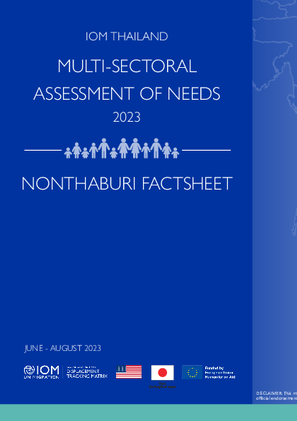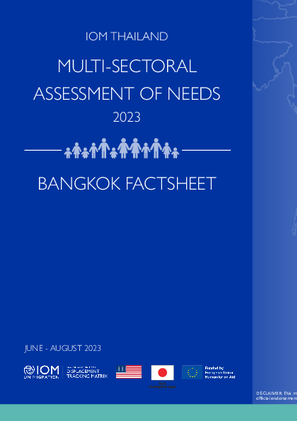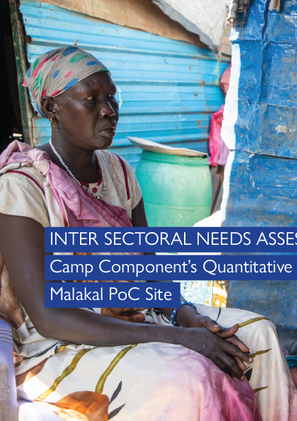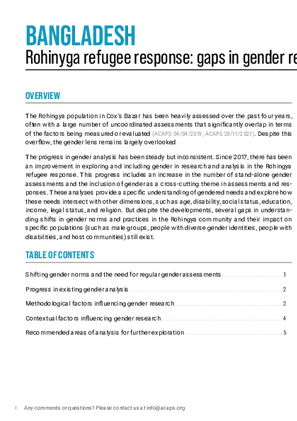-
Countries
-
Data and Analysis
-
Special Focus
-
Crisis Responses

Contact
DTMThailand@iom.int
Language
English
Location
Thailand
Period Covered
Jun 09 2023
Aug 27 2023
Activity
- Survey
- Site Assessment
This factsheet aims to provide a snapshot of multi-sectoral conditions, needs, and challenges among Myanmar migrants in Nonthaburi province as captured between June and August 2023 by IOM Thailand’s multisectoral assessment of needs. The purpose of this assessment is to provide insights regarding the severity of needs among migrant populations, identify vulnerable population groups and geographic areas with the most acute needs, inform assistance planning and relevant Sustainable Development Goals (SDGs) targets, and provide sectoral and inter-sectoral baselines for future assessments.

Contact
DTMThailand@iom.int
Language
English
Location
Thailand
Period Covered
Jun 09 2023
Aug 27 2023
Activity
- Survey
- Site Assessment
This factsheet aims to provide a snapshot of multi-sectoral conditions, needs, and challenges among Myanmar migrants in the Greater Bangkok Area as captured between June and August 2023 by IOM Thailand’s multisectoral assessment of needs. The purpose of this assessment is to provide insights regarding the severity of needs among migrant populations, identify vulnerable population groups and geographic areas with the most acute needs, inform assistance planning and relevant Sustainable Development Goals (SDGs) targets, and provide sectoral and inter-sectoral baselines for future assessments.

Contact
DTMThailand@iom.int
Language
English
Location
Thailand
Period Covered
Jun 09 2023
Aug 27 2023
Activity
- Survey
- Site Assessment
This factsheet aims to provide a snapshot of multi-sectoral conditions, needs, and challenges among Myanmar migrants in Bangkok province as captured between June and August 2023 by IOM Thailand’s multi-sectoral assessment of needs. The purpose of this assessment is to provide insights regarding the severity of needs among migrant populations, identify vulnerable population groups and geographic areas with the most acute needs, inform assistance planning and relevant Sustainable Development Goals (SDGs) targets, and provide sectoral and inter-sectoral baselines for future assessments.

Contact
DTM South Sudan, SouthSudanDTM@iom.int
Language
English
Location
South Sudan
Period Covered
Sep 01 2022
Oct 31 2022
Activity
- Survey
- Return Intention
Between September and October 2022, the International Organization for Migration’s Displacement Tracking Matrix (IOM DTM) undertook its third household-level multi-sector assessment of selected urban areas and camps for internally displaced persons (IDPs) in South Sudan. The assessment aims to:
• Quantify the prevalence of vulnerabilities and humanitarian needs across sectors, with a focus on food security, economic vulnerability and nutrition as well as selected indicators on shelter and non-food items (SNFI), education, health, water, hygiene and sanitation (WASH), protection (including child protection and gender-based violence) and mental health and psycho-social support (MHPSS).
• Generate a better understanding of urban displacement and migration, including return and relocation after displacement in South Sudan or abroad.
There has been slow progress in the humanitarian situation in South Sudan. People’s humanitarian needs continue to rise, driven by cumulative and compounding effects of years of conflict, sub-national violence, food insecurity, climate crisis and public health challenges. Conflict and insecurity, fueled by sub-national and inter-communal violence, crime, and wide-scale impunity, continue to be among the main drivers of humanitarian needs in South Sudan.
Based on the request of the Humanitarian Country Team (HCT), mandated OCHA, IOM, and REACH to implement Inter-Sectoral Needs Assessment that aimed to understand demographics, multi-sectoral needs (including the level of severity) and barriers to assistance as well as displacement patterns and household-level scale.

Contact
DTM South Sudan, SouthSudanDTM@iom.int
Language
English
Location
South Sudan
Period Covered
Sep 01 2022
Oct 31 2022
Activity
- Survey
- Return Intention
Between September and October 2022, the International Organization for Migration’s Displacement Tracking Matrix (IOM DTM) undertook its third household-level multi-sector assessment of selected urban areas and camps for internally displaced persons (IDPs) in South Sudan. The assessment aims to:
• Quantify the prevalence of vulnerabilities and humanitarian needs across sectors, with a focus on food security, economic vulnerability and nutrition as well as selected indicators on shelter and non-food items (SNFI), education, health, water, hygiene and sanitation (WASH), protection (including child protection and gender-based violence) and mental health and psycho-social support (MHPSS).
• Generate a better understanding of urban displacement and migration, including return and relocation after displacement in South Sudan or abroad.
There has been slow progress in the humanitarian situation in South Sudan. People’s humanitarian needs continue to rise, driven by cumulative and compounding effects of years of conflict, sub-national violence, food insecurity, climate crisis and public health challenges. Conflict and insecurity, fueled by sub-national and inter-communal violence, crime, and wide-scale impunity, continue to be among the main drivers of humanitarian needs in South Sudan.
Based on the request of the Humanitarian Country Team (HCT), mandated OCHA, IOM, and REACH to implement Inter-Sectoral Needs Assessment that aimed to understand demographics, multi-sectoral needs (including the level of severity) and barriers to assistance as well as displacement patterns and household-level scale.

Contact
DTM South Sudan, SouthSudanDTM@iom.int
Language
English
Location
South Sudan
Period Covered
Sep 01 2022
Oct 31 2022
Activity
- Survey
- Return Intention
Between September and October 2022, the International Organization for Migration’s Displacement Tracking Matrix (IOM DTM) undertook its third household-level multi-sector assessment of selected urban areas and camps for internally displaced persons (IDPs) in South Sudan. The assessment aims to:
• Quantify the prevalence of vulnerabilities and humanitarian needs across sectors, with a focus on food security, economic vulnerability and nutrition as well as selected indicators on shelter and non-food items (SNFI), education, health, water, hygiene and sanitation (WASH), protection (including child protection and gender-based violence) and mental health and psycho-social support (MHPSS).
• Generate a better understanding of urban displacement and migration, including return and relocation after displacement in South Sudan or abroad.
There has been slow progress in the humanitarian situation in South Sudan. People’s humanitarian needs continue to rise, driven by cumulative and compounding effects of years of conflict, sub-national violence, food insecurity, climate crisis and public health challenges. Conflict and insecurity, fueled by sub-national and inter-communal violence, crime, and wide-scale impunity, continue to be among the main drivers of humanitarian needs in South Sudan.
Based on the request of the Humanitarian Country Team (HCT), mandated OCHA, IOM, and REACH to implement Inter-Sectoral Needs Assessment that aimed to understand demographics, multi-sectoral needs (including the level of severity) and barriers to assistance as well as displacement patterns and household-level scale.
Between September and October 2022, the International Organization for Migration’s Displacement Tracking Matrix (IOM DTM) undertook its third household-level multi-sector assessment of selected urban areas and camps for internally displaced persons (IDPs) in South Sudan. The assessment aims to:
• Quantify the prevalence of vulnerabilities and humanitarian needs across sectors, with a focus on food security, economic vulnerability and nutrition as well as selected indicators on shelter and non-food items (SNFI), education, health, water, hygiene and sanitation (WASH), protection (including child protection and gender-based violence) and mental health and psycho-social support (MHPSS).
• Generate a better understanding of urban displacement and migration, including return and relocation after displacement in South Sudan or abroad.
There has been slow progress in the humanitarian situation in South Sudan. People’s humanitarian needs continue to rise, driven by cumulative and compounding effects of years of conflict, sub-national violence, food insecurity, climate crisis and public health challenges. Conflict and insecurity, fueled by sub-national and inter-communal violence, crime, and wide-scale impunity, continue to be among the main drivers of humanitarian needs in South Sudan.
Based on the request of the Humanitarian Country Team (HCT), mandated OCHA, IOM, and REACH to implement Inter-Sectoral Needs Assessment that aimed to understand demographics, multi-sectoral needs (including the level of severity) and barriers to assistance as well as displacement patterns and household-level scale.

Contact
NPM Bangladesh, NPMBangladesh@iom,int
Language
English
Location
Bangladesh
Period Covered
Jan 01 2018
Dec 31 2022
Activity
- Other
The Rohingya population in Cox’s Bazar has been heavily assessed over the past four years, often with a large number of uncoordinated assessments that significantly overlap in terms of the factors being measured or evaluated (ACAPS 04/04/2019; ACAPS 28/11/2021). Despite this overflow, the gender lens remains largely overlooked.
The progress in gender analysis has been steady but inconsistent. Since 2017, there has been an improvement in exploring and including gender in research and analysis in the Rohingya refugee response. This progress includes an increase in the number of stand-alone gender assessments and the inclusion of gender as a cross-cutting theme in assessments and responses. These analyses provide a specific understanding of gendered needs and explore how these needs intersect with other dimensions, such as age, disability, social status, education, income, legal status, and religion. But despite the developments, several gaps in understanding shifts in gender norms and practices in the Rohingya community and their impact on specific populations (such as male groups, people with diverse gender identities, people with disabilities, and host communities) still exist.

Contact
NPM Bangladesh, NPMBangladesh@iom,int
Language
English
Location
Bangladesh
Period Covered
Jan 01 2018
Dec 31 2022
Activity
- Other
- Survey
- Community Perception
In 2017, hundreds of thousands of Rohingya fled Myanmar and settled in the camps in Cox’s Bazar, Bangladesh. The scale of displacement brought obvious changes to their living conditions and changed family dynamics in the camps. One such change has been the increase in the practice of polygamy.
Legal frameworks prevented the widespread practice of polygamy among the Rohingya in Myanmar. On the other hand, based on recent reports by NGOs and UN agencies operating in the response, the practice has been increasing over the past four years in the camps. Some reasons behind the increase include changes that resulted from the sudden movement to Bangladesh, such as economic factors, gender norms, and the legal frameworks and rules and regulations applicable in the camps.
In the Rohingya refugee camps, where protection concerns are already very high, the increase in polygamy likely contributes to aggravating different forms of sexual and gender-based violence.

Contact
NPM Bangladesh, NPMBangladesh@iom,int
Language
English
Location
Bangladesh
Period Covered
Jan 01 2018
Dec 31 2022
Activity
- Other
In late 2021, ACAPS’ Cox’s Bazar Analysis Hub embarked on research to understand the development of humanitarian needs in the Rohingya refugee crisis. The research was mainly based on the comparison of findings from four consecutive years (2018–2021) of Multi Sector Needs Assessments (MSNAs). The report titled Needs and Priorities of Rohingya and Host Communities in Cox’s Bazar since 2017 was published on 30 August 2022.
The 2019 Rohingya MSNA aimed to “provide an analysis of how refugees’ population and host communities’ needs have changed in 2019”, while the 2020 and 2021 Rohingya MSNAs aimed “to facilitate an understanding of the evolution of needs and service gaps across time” (ISCG 05/2019, 06/05/2021, and 08/08/2022). Despite the similarity, direct comparisons of the yearly situations still proved challenging.
This technical note outlines the key challenges the ACAPS team faced while analysing and comparing data across multiple MSNAs. To develop an understanding of the Rohingya crisis over time, the team included other sources of information, such as the WFP Rohingya Influx Emergency Vulnerability Assessments (REVAs), especially for food and livelihood needs, and information supplied specifically from the sectors. On that note, similar comparability issues were also observed with these other assessments and information sources.
This note aims to highlight how assessment design, data collection, and results presentation enable (or prevent) trends analysis. It also aims to encourage assessment designers and coordinators to consider the future use of their data with the immediate requirements, even as they seek to improve data collection or overcome changes based on the context of the people in need.

